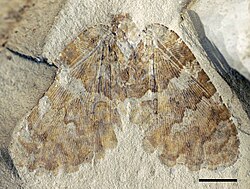| Silky lacewings Temporal range: | |
|---|---|
 | |
| Psychopsis insolens | |
 | |
| Undulopsychopsis alexi | |
| Scientific classification | |
| Domain: | Eukaryota |
| Kingdom: | Animalia |
| Phylum: | Arthropoda |
| Class: | Insecta |
| Order: | Neuroptera |
| Superfamily: | Psychopsoidea |
| Family: | Psychopsidae Handlirsch, 1906 |
| Genera | |
| |
Psychopsidae is a family of winged insects of the order Neuroptera. They are commonly called silky lacewings.
Contents
The silky lacewings are distinguishable in their adult stage by their spectacularly patterned and pubescent wings, broad wing shape, dense venation, and the presence of a vena triplica (the apical fusion of three veins in the hindwing). [1] [2]